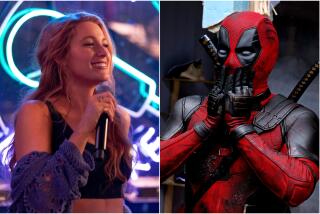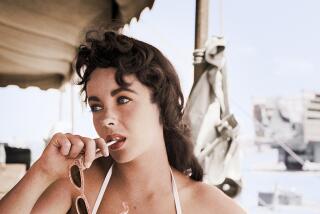Appreciation: How Debbie Reynolds lost, won and lost again her battle to preserve a studio’s treasures
“It is the hardest thing I have ever done.”
Knowing that her life had included the public humiliation of losing a husband to Elizabeth Taylor, two more marriages that left her on the edge of financial ruin, a roller coaster of a screen and stage career, health issues and raising two children more or less on her own, I was a bit taken back by the firmness of Debbie Reynolds’ declaration.
For the record:
11:00 p.m. Jan. 1, 2017In a previous version of this story, Debbie Reynolds’ “Singing in the Rain” character Kathy Selden was misspelled as Seldon.
She was talking about selling off her collection of Hollywood costumes and memorabilia that she had lovingly protected for 40 years, beginning in 1969 when Kirk Kerkorian bought MGM and installed Jim Aubrey to cut costs and budgets in search of profits. Ted Turner bought the film library, which left the studio grounds and all its holdings, including props, costumes, scripts and ephemera. Debbie had a plan. Passionate in her belief that movies were an art form worth celebrating and their treasures worth preserving, she arranged a $5-million loan to buy everything but the lot and urged Aubrey and Kerkorian to create a Disney-type mecca for film fans. She even volunteered “to man turnstile Number 3” once a week, but Debbie said that all Aubrey “could see in front of him was little Kathy Selden from ‘Singin’ in the Rain.’”
Instead, he sold everything to auctioneer David Weisz to be auctioned off piece by piece.
Reynolds was crushed, but not deterred. And, looking back, she said with a wry smile, “It’s not that I had so much vision, it’s just that they had none.”
She enlisted her friend, the art director Jerry Wunderlich (“He knew which were real antiques and what was just made quickly in the prop department”), and for three weeks straight during that May 1970 auction they bought everything they could that they considered of value. Reynolds remembered barely sleeping, and when she had to run to the bathroom on the other side of the lot, she instructed the teenage granddaughter of Harold Lloyd, Suzanne, “to just sit tight and keep the paddle up.”
The result of Debbie’s several-hundred-thousand-dollar outlay turned out to be worth $25 million when she was finally forced to sell her collection in 2011. She had made multiple attempts over the decades to keep everything together, but as she put it, “You can’t be a one-woman parade,” let alone the one who’s picking up the tab for everything along the way. (It’s heartbreaking to realize that after turning her down several times, the Academy of Motion Picture Arts and Sciences became serious about a museum two years after Debbie had sold it all.)
It is fitting that the career of the woman who will always be respected for valuing Hollywood costumes began with a blouse. That was one of the prizes offered in the Miss Burbank contest of 1948, and the then-16-year-old high school student was desperate to expand her wardrobe. With several studio reps in the audience, little Mary Frances Reynolds won the title, the blouse and a seven-year studio contract.
That grit and determination, always with a smile on her face, would serve her well as Debbie Reynolds during her almost 70 years in the movie business. Playing Tammy, Kathy Selden, the Unsinkable Molly Brown, Mother and dozens of other roles, and appearing on stage when the screen didn’t beckon, Debbie was a formidable force, loved by generations of fans.
Initially, she had no idea what she was getting herself into. In contrast to the 1910s and ’20s, when women were commonplace as writers, producers and even directors, and actresses tended to be friends off the studio lots, the ’50s were a lonely and isolating time for women in Hollywood. At meetings of the Directors Guild, speakers would address the group with “Gentlemen, and Miss Lupino,” acknowledging their lone female member, Ida Lupino. Actresses were actively encouraged by their bosses to compete with each other instead of sharing their interests and concerns, but Debbie never bought in. She befriended her fellow thespians and always looked beyond herself for meaning and satisfaction.
She was one of the founders and first president of the Thalians in the mid-’50s, bringing then-young Hollywood together to fund ways to help children with mental illness at a time when it was barely spoken about in public. (Over the past 60-plus years the organization, still going strong, has raised millions of dollars for projects such as the Mental Health Center at Cedars-Sinai.) Debbie was also an early advocate and fundraiser for AIDS research. She and Elizabeth Taylor would eventually repair their friendship that had begun as teenagers at MGM where they were dubbed “The Movie Star and the Girl Scout.” They recognized that what they shared was so much more important than the men they had left behind.
Maintaining her friendships was important to Debbie, and her home reflected that with pictures everywhere of family and friends. Amid the overstuffed couch and chairs were the individual pieces — Harold Lloyd’s player piano and his gilded mirror over her fireplace, with Eva Gabor’s African-style sculptures alongside. In other corners, Agnes Moorhead’s lamps stood alongside items from Debbie’s beloved MGM teacher Lillian Burns, whom she cared for at the end of her life — blended together, it became uniquely Debbie. In yet another link to Hollywood history, the house had once been owned by the costume designer Edith Head.
And with just 50 yards separating their front doors, she and her daughter, Carrie, had become the closest of friends. As if that wasn’t near enough, when Debbie found herself forgetting some little detail in a story, she would just reach for the phone and call Carrie, always confident she would know.
After years of an intense, push-and-pull relationship, the passionate, multitalented mother and daughter, who had lived so much of their lives in the public eye, had made as much of a peace as was possible. The harmony that was created when they laughed simultaneously was close to divine.
Of course, now we know that the hardest thing Debbie ever did wasn’t selling the costumes, it was facing life without Carrie just a call or a yell up the hill away. Their deaths 24 hours apart is surreal and yet somehow blessed. They will stay with us in their films, books and their HBO documentary “Bright Lights,” which will air Jan. 7, but they — and their laughs — will be so missed by so many.
Cari Beauchamp is the author of “Without Lying Down: Frances Marion and the Powerful Women of Early Hollywood” and five other books of film history. She first met Debbie Reynolds while interviewing the actress for her books and then went through her costume auction with her.
More to Read
Only good movies
Get the Indie Focus newsletter, Mark Olsen's weekly guide to the world of cinema.
You may occasionally receive promotional content from the Los Angeles Times.










